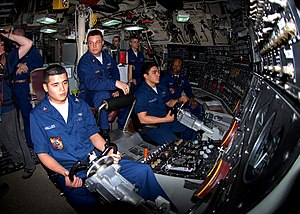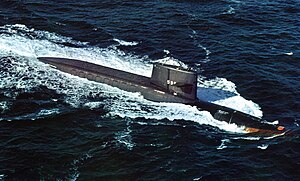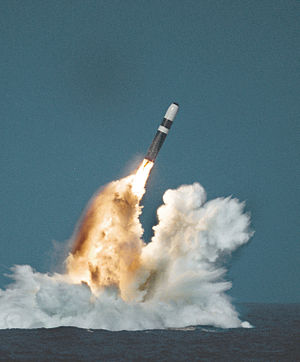Peace Through Superior Firepower/Missile Submarines

Known by the designator SSBN in NATO parlance, ballistic missile submarines are the premier type of nuclear weapon, benefiting from mobility, stealth and the ability to wait for months before launching missiles.
The US now has 14 "boomers" in service. These operate with two crews, a Blue and a Gold crew, who alternate on deployments that last about 60 days at a time. However they can go on for up to and over 6 Months at a time should the Navy so will it and they pre-stock the sub for such a mission.
This category also includes sub-launched ballistic missiles.
Submarines
Cruise Missile Subs

Prior to the first ballistic missile submarines, the USN had four modified WW 2-era attack submarines (so diesel-powered) carrying nuclear cruise missiles: namely, the SSM-N-8 Regulus. They were joined by USS Halibut (SSGN-587), a nuclear-powered submarine.
They made strategic deterrent patrols up until 1964, when Polaris made these boats and the missiles they carried rather obsolete. Halibut became a special operations boat until retirement in 1976.
Today, the shrinking size of technology means that a nuclear-armed Tomahawk cruise missile can fit inside and be launched from the torpedo tubes of a standard attack submarine. Do note that the newest American SS Ns have vertical launch tubes designed specifically for cruise missiles, though the Navy's nuclear Tomahawk has been long withdrawn as part of strategic arms drawdowns.
The four oldest Ohio class submarines have also been converted into dedicated cruise missile carriers.
George Washington class

These were the very first American SSBNs, and carried several variants of the UGM-27 Polaris. The first two were converted from under-construction Skipjack class SSNs, with three more specifically built.
To make room from the Ohio class under SALT II limits, three were converted to attack submarines. All were decommissioned by 1986.
It carried 16 SLBMs.
- Ethan Allen class SSBN: Five of these were built. Ethan Allen was the only boomer to have done a full SLBM test, complete with nuclear detonation at the end, in 1962.
- Ethan Allen herself features in the novel of The Hunt for Red October, being blown up so that the Soviets will be convinced Red October has been destroyed.
- Lafayette class: 31 of this basic type are built, but they were divided into three classes. The first nine were this type. Designed for Poseidon, but initially carried Polaris A2, until they were fitted with the former.
- James Madison class: Second type of Lafayette, with ten built. Just carried a longer-ranged version of Polaris, the A3.
- Benjamin Franklin class: Quieter subs and other improvements. Not much else though.
- 41 for Freedom: The George Washington, Ethan Allen, Lafayette, James Madison and Benjamin Franklin classes, taken together. Initially all Polaris boats, if this troper isn't mistaken; later, some were upgraded to carry, instead of the aging, obsolescent Polaris, either Poseidon or Trident.
Ohio class

Though now aging, these remain the primary class of "boomer" submarine in the USN until deployment of the Columbia class is completed. They're also amongst the largest subs ever built, only beaten by the Russian Typhoon class, though the Ohios beat them out in raw firepower thanks to four more missile tubes. Designed to carry the Trident missile from the get-go, and later being modified to carry the improved D-5 variant. The four earliest submarines have been further converted to cruise missile submarines.
Columbia class

A new SSBN class has been announced around 2010 as a replacement for the class. Construction of the first began in 2020, with deployment expected by the end of the 2020s.
Missiles

- UGM-27 Polaris series: The very first American SLBMs. Not ICBMs; they were only intermediate-range, which meant that the SSBNs carrying them had to stay relatively close to their targets (Eastern Med or Arctic Circle). This became more and more of a shortcoming as the years went by. Initially it carried a single nuclear warhead, which was later upgraded to three warheads, each in its own multiple reentry vehicle. (They weren't MIRVs; it was a way of putting more warheads on a single target.)
This system also ended up constituting much of the UK's nuclear deterrent as well, although they developed their own warheads, and in the case of Chevaline and the modified Polaris A3TK, added their own countermeasures and penetration aids, in order to ensure that they could vaporize Moscow despite the ABM system the Soviets had put up around their capital.
- UGM-73 Poseidon: The successor to the UGM-27 Polaris in USN service. It carried more warheads and it was rather more accurate. Still not an ICBM, though. Carried true MIRVs, potentially as many as 14. It was an excellent second-strike weapon against soft targets, the result of a political decision.
- UGM-96A Trident-I C4- first version of the missile, with a range of 4,000 miles (6437 km), eight 100-KT warheads and three stages.
- UGM-133A Trident-II D5- the improved version with 600 miles more range, 14 (!- although eight is more normal and anything over 10 is a violation of arms treaties) 335-KT (!) warheads and an improved silo penetration ability (!). Sold to Britain (sans warheads; equipped with British-design warheads in Royal Navy service).